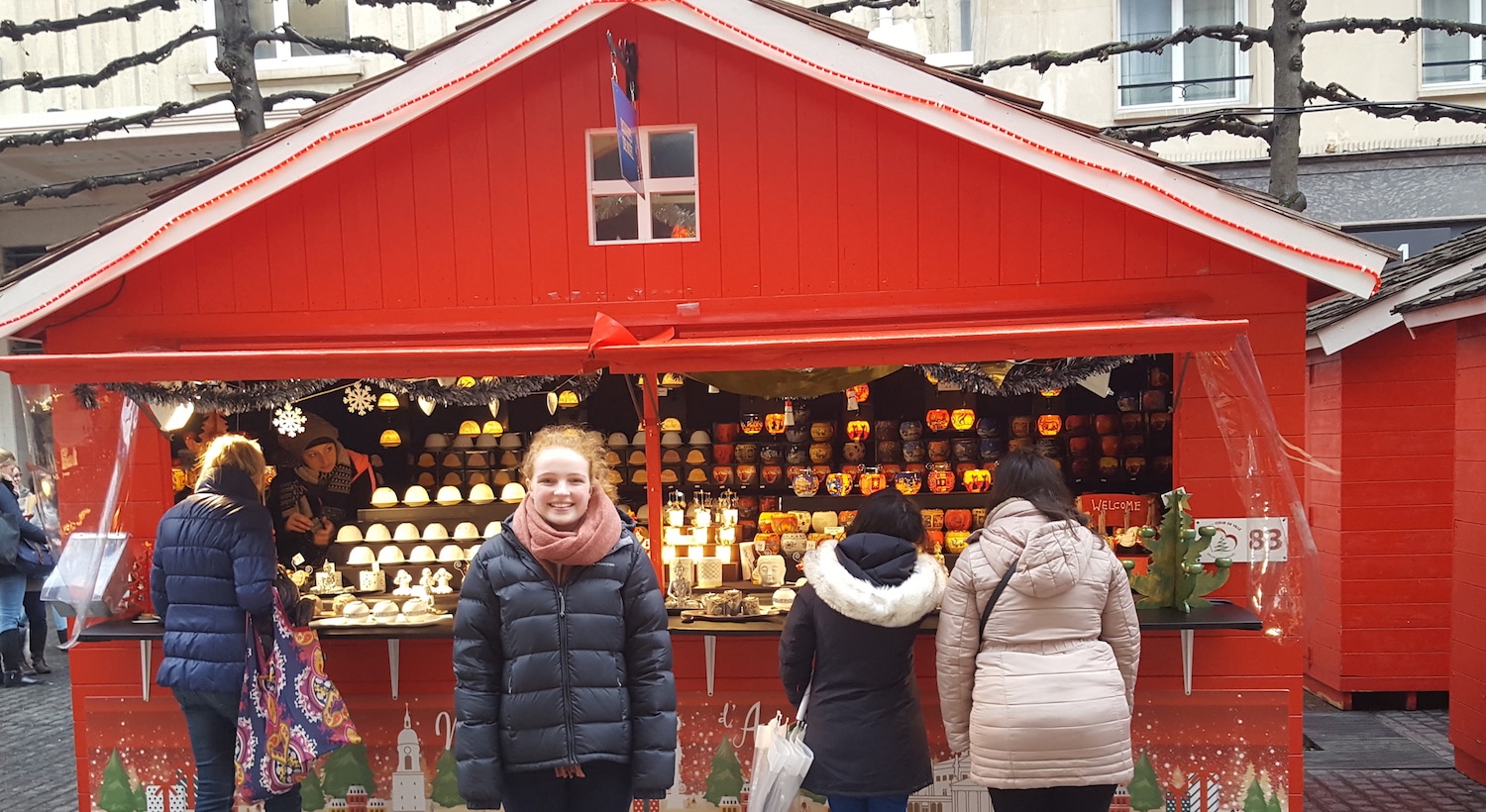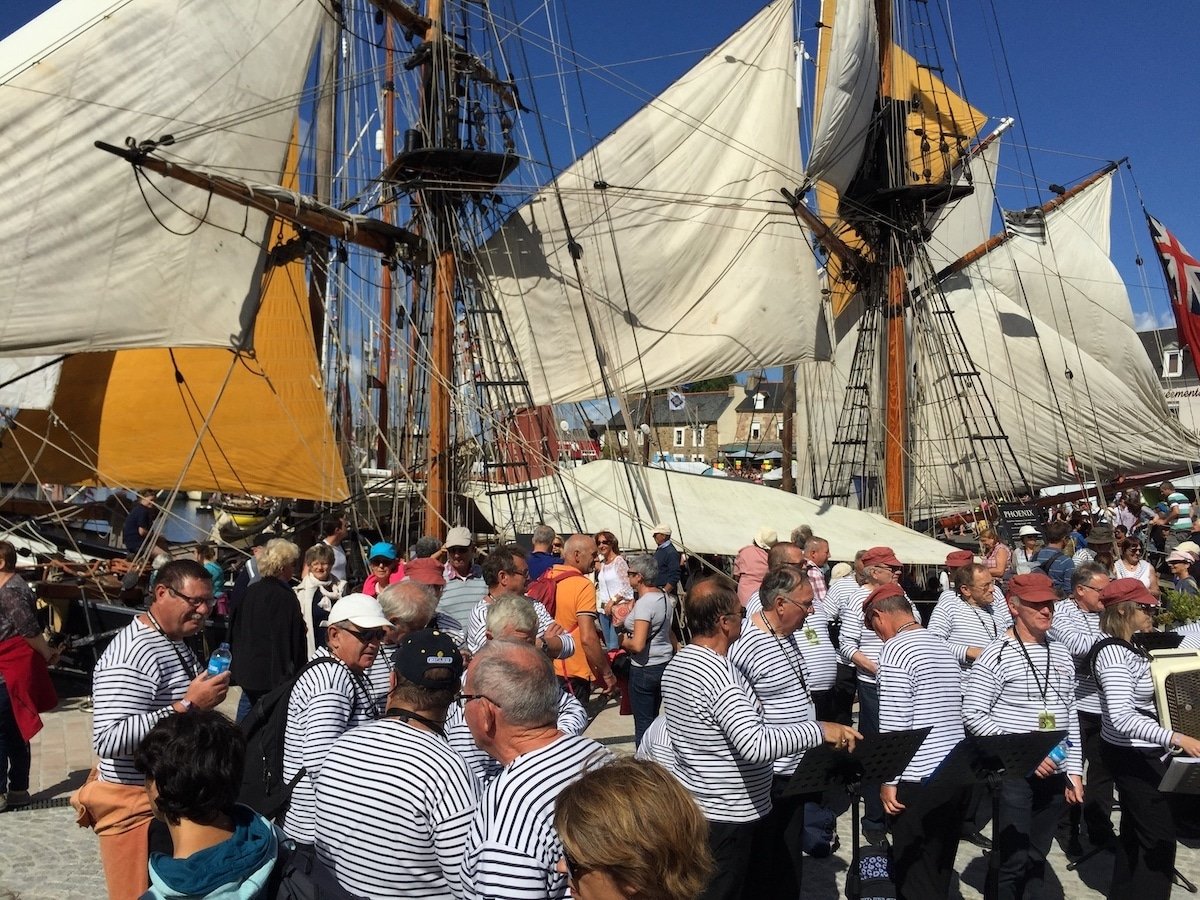Brittany, Important Pork Producer
Use the floating blue icon in the bottom right to hide/reveal the English translations below or just click here.
La Bretagne est une région agricole, et on y élève beaucoup de cochons, particulièrement autour de Lamballe dans les Côtes d’Armor, notre département. Et voilà, le village de Trédias, 500 habitants, à 30 kilomètres de Lamballe et à 14 km de Jugon les Lacs, organise chaque année une fête du cochon.
Brittany is an agricultural region, and a lot of pigs are raised, especially around Lamballe in the Côtes d’Armor, our department. And here, the village of Trédias, 500 inhabitants, 30 kilometers from Lamballe and 14 km from Jugon les Lacs, organizes a pig festival each year.
Our Breton Dance Group: La Rosargue

Les organisateurs ont contacté notre groupe de danse bretonne, La Rosargue, pour nous inviter à animer la fête. Animer dans notre cas, ça veut dire danser en costume traditionnel pendant que les gens mangent, et pendant les autres activités associées à la fête.
The organizers contacted our Breton dance group, La Rosargue, to invite us to animate the party. Animating in our case means dancing in traditional dress while people eat, and during other activities associated with the party.
Avant d’y aller, je regarde des descriptions de La fête du cochon à Trédias sur internet. Ça commence le matin avec la découpe du cochon à l’ancienne, et la préparation de pâté. A 13 heures, il va y avoir un repas champêtre, ‘dans une ambiance d’autrefois’. Pour avoir plus d’informations, il faut contacter le fournil, c’est-à-dire la boulangerie, parce que c’est Christian, le boulanger du village qui est président de l’association qui organise la fête. http://www.infolocale.fr/tredias_22348_le-four-a-mie_19320/agenda/repas–soiree/fete-du-cochon_4009902?date_debut=01-01-2017&date_fin=31-12-2017
Before I go, I look at descriptions of La fête du cochon in Trédias on the internet. It begins in the morning with the cutting up of the pig in the old way, and the preparation of pâté. At 1 pm, there will be a country meal, ‘in an atmosphere of yesteryear’. For more information, it is necessary to contact the bakery, because it is Christian, the village baker who is the president of the association that is organizing the festival.
[ftimmersion_ad]
Preparing the Pork For Cooking
Le jour de la fête, je descends à Jugon où s’organise un covoiturage pour aller à Trédias. Là, le public commence à se rassembler autour de la buvette installée devant la boulangerie. Les gens prennent un apéritif et ils regardent l’équipe de bénévoles qui prépare le porc de trois cochons juste à côté, sous un deuxième chapiteau.
On the day of the fête, I go down to Jugon where a carpool is organized to go to Trédias. There, the public are beginning to gather around the refreshment bar in front of the bakery. They have an aperitif and watch the team of volunteers preparing the pork from three pigs next to them under another marquee.
Dancing Breton Dances
Et puis nous dansons : des danses de défilé, des danses en rond, des danses en ligne et en quadrette. Le public applaudit. Puis nous défilons, tout en dansant, dans la direction du grand hangar où on va manger.
And then we dance: parade dances, dances in a circle, line dances and foursomes. The audience applauds. Then we go off in a procession, dancing, in the direction of the open barn where we are going to eat.

Spend a week in the beautiful harbour town of Paimpol on the North Coast of France.
A Nicely Decorated Barn
Le hangar est décoré : sur les tables, des noisettes et des épis de blé, et puis suspendus au-dessus de nos têtes, des vêtements traditionnels de paysans et de paysannes, et oh ! regardez ! des jolis petits cochons en tricot rose. Qu’est-ce qu’ils sont mignons !
The barn is decorated: on the tables, hazelnuts and ears of wheat, and then suspended above our heads, traditional farmers’ garments and oh! look ! pretty little pink knitted pigs. Aren’t they cute !

Accordion Player
Le hangar commence à se remplir, et nous dansons encore autour des tables pendant que les gens attendent le premier plat. Pas beaucoup de place pour danser, par contre, alors c’est Serge à l’accordéon qui prend la relève. Il enchaîne des chansons que tout le monde connaît plus ou moins bien, des standards de la variété française, et on chante avec lui. L’ambiance est festive et joyeuse. Pierre, grand amateur de photographie, est partout à capturer l’événement en photo. Je commence à penser que ceci ferait un très bon sujet pour un article sur French Today…
The barn is beginning to fill up, and we dance again around the tables while the people wait for the first course. There’s not much space to dance, though, so Serge takes over on the accordion. He plays a string of songs that everyone knows more or less well, popular French standards, and we sing with him. The atmosphere is festive and joyful. Pierre, a great lover of photography, is everywhere capturing the event in photos. I am beginning to think that this would make a very good subject for an article on French Today …

Dehors, une pluie fine commence à s’installer (c’est l’automne, c’est la Bretagne !). Mais là, sous le hangar, nous sommes à l’abri et nous mangeons bien.
Outside, a fine rain is beginning to take a hold (it’s autumn, it’s Brittany!). But here, under the barn, we are under cover and we eat well.
First Course – Pork Cold Cuts

Le premier plat, c’est de la charcuterie, bien sûr : du pâté de campagne, fait la veille par le boucher du village de l’andouille et du saucisson. Puis le plat principal : côte de porc grillé avec pommes de terre. Le crachin – la pluie fine – s’arrête, et nous recevons l’ordre de notre chef de danser un peu, juste devant le hangar.
The first dish is pork cold cuts, of course: country pâté, made the day before by the village butcher, chitterlings and sliced sausage. Then the main course: grilled pork chop with potatoes. The drizzle – the fine rain – stops, and we receive orders from our boss to dance a little, just in front of the hangar.

Puis pendant que les musiciens sont debout, on chante ‘Joyeux anniversaire’ à deux personnes présentes qui célèbrent leur anniversaire aujourd’hui. En parlant avec une des bénévoles, j’apprends que Christian est sur le point de sortir des petits pâtés du four. Elle m’invite à aller le voir…
Then while the musicians are on their feet, we sing ‘Happy Birthday’ to two people present who are celebrating their birthday today. Speaking with one of the volunteers, I discover that Christian is about to get some small patés out of the oven. She invites me to go and see him …

Que ça sent bon au fournil ! Ces pâtés sont à vendre plus tard dans l’après-midi.
How good it smells in the bakehouse! These pâtés will be for sale later in the afternoon.
De retour sous le hangar, je découvre que les plats suivants ont été servis. Un trou normand (du sorbet avec du calvados) et puis une assiette de fromage. Un peu plus tard, voilà le dessert qui arrive, une délicieuse crème vanille maison. Est-ce qu’on va pouvoir continuer à danser après toute cette bonne “popote” ?
Back in the hangar, I discover that the next dishes have been served. A ‘trou normand’ (sorbet with calvados) and then a plate of cheese. A little later, the dessert arrives, a delicious home-made vanilla cream. Are we going to be able to continue dancing after all this good food (common slang)?
Dancing With the Public
Heureusement, rien ne presse, et nous avons le temps de digérer, de continuer à parler, et de prendre un petit café avant de danser à nouveau. Nous exécutons des danses de spectacle puis des danses plus faciles où nous invitons le public à danser avec nous.
Fortunately, there is no hurry, and we have time to digest, keep talking, and have a small coffee before dancing again. We do display dances and then easier dances where we invite the public to dance with us.

Locally Produced Pork Sale
Mais la fête ne touche pas encore à sa fin, ah non, loin de là ! Maintenant il est temps de défiler encore, cette fois dans la direction de la buvette où les bénévoles vont organiser la vente de pâtés, de saucisses, de rôtis de porc, de jarrets, et autres, et de pains et de brioches à la boulangerie. Entre deux danses, j’achète un kilo de saucisses. Les ventes vont bon train. Tous les ingrédients sont naturels, et les cochons viennent d’un élevage local.
But the fête is not yet over, no, far from it! Now it’s time to go in a procession again, this time in the direction of the ‘buvette’ bar where the team of volunteers are going to organize the sale of pâté, sausages, pork roasts, hocks, and the like, and bread and soft bread loaves at the bakery. Between two dances, I buy a kilo of sausages. Sales are going well. All the ingredients are natural, and the pigs come from a local farm.
Une demi-heure plus tard, il ne reste pas beaucoup de porc à vendre, mais un peu quand même. Puis nous découvrons la tradition de cette fête : finir par une vente aux enchères ‘au cadran’, une enchère hollandaise où on commence par annoncer un prix élevé, puis on réduit le prix progressivement jusqu’à ce que quelqu’un achète l’article en question. Je suis la procédure avec intérêt, et j’achète un rôti de porc.
Half an hour later, there is not much left to sell, but a little remains. Then we discover the tradition of this festival: ending with an auction ‘au cadran’, a Dutch auction where they start by announcing a high price, then they reduce the price gradually until someone buys the item in question. I follow the procedure with interest, and I buy a pork roasting joint.
Et voilà, tout est vendu et les gens commencent à partir. Les dernières conversations, notre dernière interprétation de notre danse emblématique ‘Le Bal de Jugon’, beaucoup de sourires et de remerciements, et il est temps de partir, nous aussi. Dans le covoiturage pour rentrer à Jugon, nous sommes fatigués mais contents… et je commence à réfléchir à ce que je vais mettre dans mon article pour French Today…
And then, everything is sold and people start to leave. The last conversations, our last interpretation of our emblematic dance ‘Le Bal de Jugon’, many smiles and thank yous, and it’s time for us to leave, too. In the carpool to return to Jugon, we are tired but happy … and I start to think about what I will put in my article for French Today …
Crédits et remerciements à Pierre Vola pour plusieurs photos.
If you liked this article, why not consider a stay at Suzanne’s home in Brittany to better your French? Here is more info about the French Immersion Residential courses recommended by French Today.









Comments